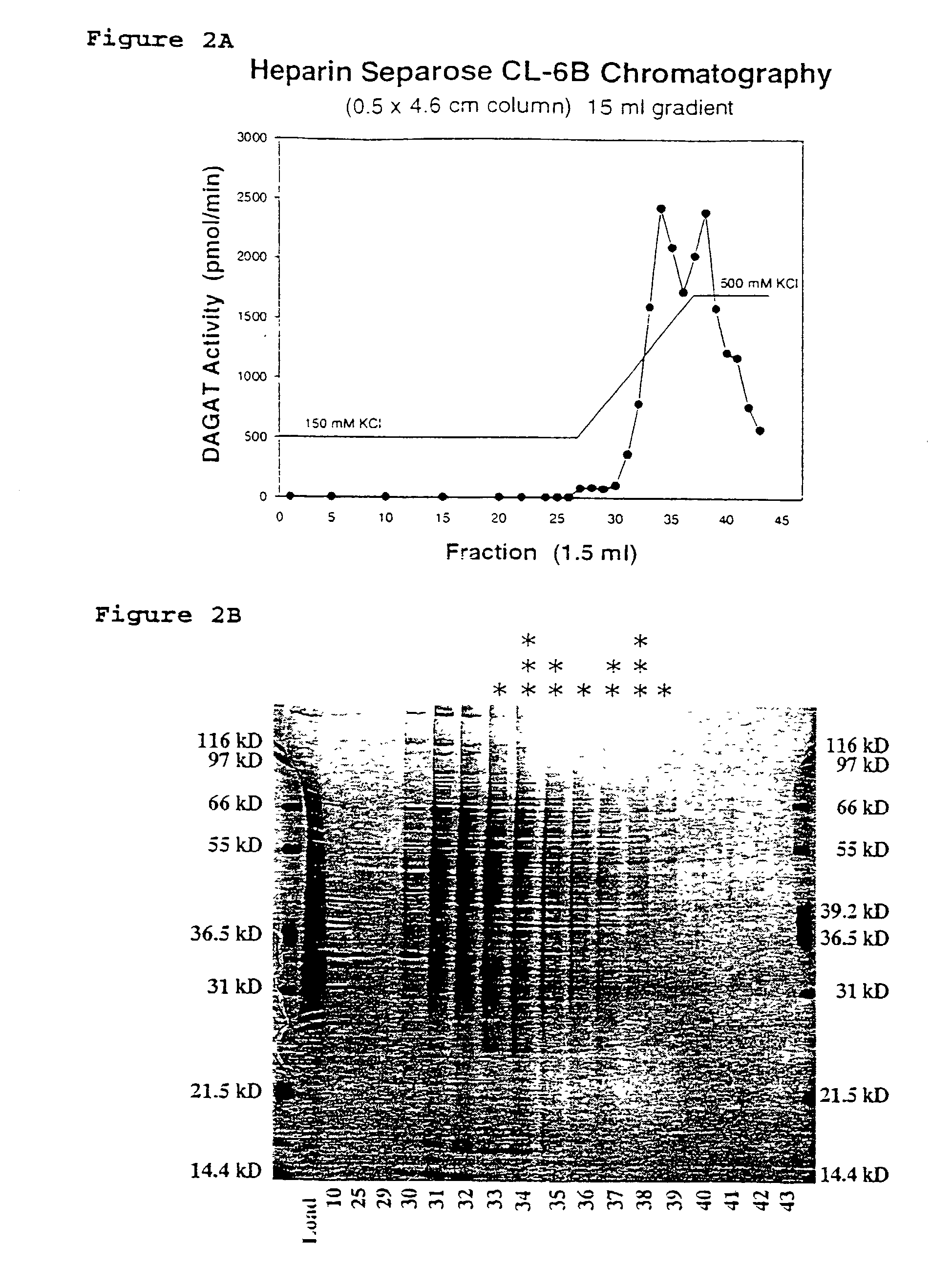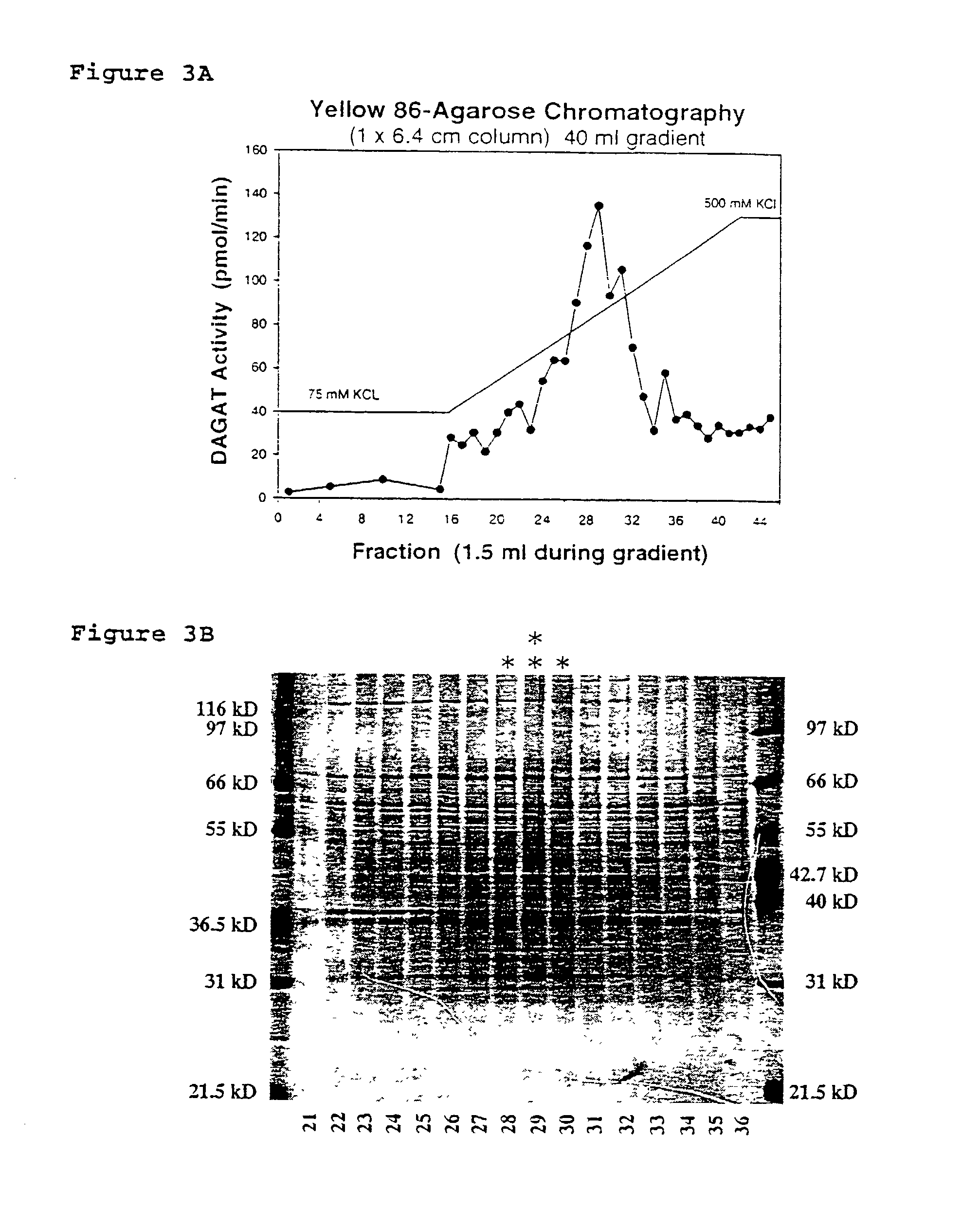Diacylglycerol acyl transferase proteins
- Summary
- Abstract
- Description
- Claims
- Application Information
AI Technical Summary
Benefits of technology
Problems solved by technology
Method used
Image
Examples
example 1
Diacylglycerol Acyltransferase (DAGAT) Assays
[0199]Methods to assay for DAGAT activity in non-solubilized or solubilized protein preparations are described for Mortierella ramanniana. [0200]A. Non-solubilized samples
[0201]DAGAT activity is assayed with 3.67 μM 1-14C-18:1-Coenzyme A (53.5–54.5 Ci / mole, New England Nuclear, Boston, Mass.) and 1.5 mM 1,2–18:1 diacylglycerol (DAG) (Sigma D-0138, prepared as a 150 mM stock in 2-methoxyethanol) in a buffer containing 10 mM potassium phosphate (pH 7.0), 100–150 mM KCl, and 0.1% TX-100 (w / v) in a total volume of 100 μl as similarly described by Kamisaka et al. (1993) supra and Kamisaka et al. (1994) supra. Assays are performed at 30° C. for 5 min and terminated with the addition of 1.5 ml of heptane:isopropanol:0.5M H2SO4 (10:40:1, v / v / v). If necessary, samples may be diluted with buffer prior to assay in order to maintain a linear rate of product formation during the assay.[0202]B. Solubilized samples
[0203]The assay is performed as describ...
example 2
Mortierella ramanniana Culture Conditions
[0206]Mortierella ramanniana is cultured by inoculating 1 liter of Defined Glucose Media (30 g glucose, 1.5 g (NH4)2SO4, 3 g K2HPO4, 0.3 g MgSO4.7H2O, 0.1 g NaCl, 5 g CH3COONa.3H2O, 10 mg FeSO4.7H2O, 1.2 mg CaCl2.2H2O, 0.2 mg CuSO4.5H2O, 1.0 mg ZnSO4.7H2O, 1.0 mg MnCl2.4H2O, 2 mg thiamine-HCl and 0.02 mg biotin in 1 L of water purified by reverse osmosis (pH 5.7)) with 1.5–3×106 spores and incubating at 30° C. with shaking at 200 rpm for 9–11 days. Cultures are harvested by filtration through one layer of Miracloth (Calbiochem, La Jolla, Calif.). Excess liquid is removed by hand squeezing. The average yield of packed cells per liter harvested is 22.5 g.
example 3
SDS-PAGE Analysis
[0207]Samples from the column fractions are diluted in SDS-PAGE sample buffer (1× buffer=2% SDS w / v, 250 mM β-mercaptoethanol, 0.0025% bromphenol blue) and analyzed by electrophoresis. Polyacrylamide gradient gel electrophoresis (10–13%) is carried out according to the method of Laemmli ((1970) Nature 227:680–685) with some of the modifications of Delepelaire (1979) Proc. Natl. Acad. Sci. USA 76:111–115. Sodium dodecyl sulfate is used in the upper reservoir buffer at 0.1% but is omitted from the lower reservoir buffer, stacking and resolving gels. The stacking gel contains 5% of a 30% acrylamide stock (acrylamid;N,N′-Methylenacrylamid, 37.5:1, Bio-Rad, Hercules, Calif.), 0.06% ammonium persulfate and 0.1% TEMED (v / v). The resolving gel contains a 10–13% linear gradient of acrylamide stock stabilized by a 0–10% linear gradient of sucrose. Electrophoresis is carried out at room temperature at 150V, constant voltage, for 7–9 hours. Proteins are visualized by staining w...
PUM
| Property | Measurement | Unit |
|---|---|---|
| Atomic weight | aaaaa | aaaaa |
| Atomic weight | aaaaa | aaaaa |
| Molecular weight | aaaaa | aaaaa |
Abstract
Description
Claims
Application Information
 Login to View More
Login to View More - R&D
- Intellectual Property
- Life Sciences
- Materials
- Tech Scout
- Unparalleled Data Quality
- Higher Quality Content
- 60% Fewer Hallucinations
Browse by: Latest US Patents, China's latest patents, Technical Efficacy Thesaurus, Application Domain, Technology Topic, Popular Technical Reports.
© 2025 PatSnap. All rights reserved.Legal|Privacy policy|Modern Slavery Act Transparency Statement|Sitemap|About US| Contact US: help@patsnap.com



